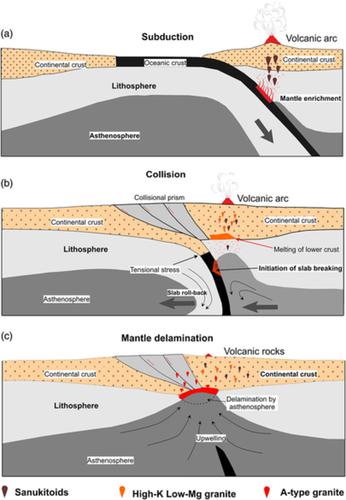当前位置:
X-MOL 学术
›
Geolog. J.
›
论文详情
Our official English website, www.x-mol.net, welcomes your
feedback! (Note: you will need to create a separate account there.)
Redox series assessment, petrogenetic, and geodynamic appraisal of Neoarchean granites from the Bundelkhand Craton, Central India: Constraints from phase petrology and bulk rock geochemistry
Geological Journal ( IF 1.4 ) Pub Date : 2021-02-01 , DOI: 10.1002/gj.4087 Gajender Kumar 1 , Santosh Kumar 1 , Mekala Ram Mohan 2
Geological Journal ( IF 1.4 ) Pub Date : 2021-02-01 , DOI: 10.1002/gj.4087 Gajender Kumar 1 , Santosh Kumar 1 , Mekala Ram Mohan 2
Affiliation

|
Based on field relationships, microstructure, phase petrology, and whole-rock elemental geochemistry, we have unravelled the redox conditions and petrogenetic evolution of Neoarchean granites (sensu lato) from the central part of the Bundelkhand Craton, Central India. The studied Neoarchean granites are sanukitoids (sensu lato), high-K, low-magnesian granites (HKLMG), and oxidized A-type granites (OAG). Chemistry of biotite in conjunction with amphibole compositions from sanukitoids indicates their crystallization in calc-alkaline felsic host magma formed in a subduction setting at elevated fugacity of oxygen (fO2), buffered at +2 fayalite-magnetite-quartz (FMQ), corresponding to magnetite series granite. Chemistry of biotite and amphiboles from HKLMG suggests that host melts of these phases buffered above +1 FMQ, that is, moderate fO2 condition corresponding to magnetite series granites. The nature of the HKLMG magma is peraluminous to alkaline which originated at a relatively high-P condition. The biotites from OAG exhibit pronounced Al-Fe substitution buffered above +0.5 FMQ to represent oxidized A-type host granite magma, belonging to magnetite series granite. The sanukitoids bear high ferromagnesian minerals (FeOt + MgO + MnO + TiO2 (FMMT) >4.5; Mg# = 28–45), and enriched incompatible elements without significant Eu anomalies, probably originated from melt-enriched mantle source in a subduction setting. The HKLMG are characterized by relatively low Mg#, TiO2, high K-LILEs-REEs with negative Eu anomalies, and high Th/Nb, Ce/Pb, and La/Nb ratios, which suggest mixed source signatures, derived from the enriched mantle and continental crust. A-type granites (OAG) bear high NK/A (molar Na2O + K2O/Al2O3 ~ 1.17), FeOt/MgO, K2O/Na2O, Ga/Al, and Ce–Y, which indicate the emplacement of OAG magmas in syn- to post-collisional tectonic environments. Thus, the Neoarchean granites from the Bundelkhand Craton represent a collage of subduction related sanukitoids to high-K magnesian granites, and syn- to post-collisional oxidized A-type granites.
中文翻译:

印度中部邦德尔坎德克拉通新太古代花岗岩的氧化还原系列评估、岩石成因和地球动力学评估:相岩石学和大块岩石地球化学的约束
基于场关系、微观结构、相岩石学和全岩元素地球化学,我们揭示了印度中部邦德尔坎德克拉通中部新太古代花岗岩(sensu lato)的氧化还原条件和岩石成因演化。研究的新太古代花岗岩是 sanukitoids (sensu lato )、高钾、低镁花岗岩 (HKLMG) 和氧化 A 型花岗岩 (OAG)。黑云母的化学与来自 sanukitoids 的角闪石成分结合表明它们在钙碱性长英质寄主岩浆中结晶,该岩浆是在氧逸度升高的俯冲环境中形成的 ( f O 2),缓冲在 +2 铁橄榄石-磁铁矿-石英 (FMQ),对应于磁铁矿系列花岗岩。来自 HKLMG 的黑云母和角闪石的化学表明,这些相的主体熔体缓冲在 +1 FMQ 以上,即中等f O 2条件对应于磁铁矿系列花岗岩。HKLMG 岩浆的性质是过铝至碱性,其起源于相对较高的P条件。来自 OAG 的黑云母表现出明显的 Al-Fe 取代,缓冲在 +0.5 FMQ 以上,代表氧化的 A 型主体花岗岩岩浆,属于磁铁矿系列花岗岩。sanukitoids 含有高铁 镁矿物 (FeO t + MgO + MnO + TiO 2(FMMT) >4.5;Mg# = 28-45),以及没有显着 Eu 异常的富集不相容元素,可能起源于俯冲环境中富含熔体的地幔源。HKLMG 的特征是相对较低的 Mg#、TiO 2、具有负 Eu 异常的高 K-LILEs-REE,以及高的 Th/Nb、Ce/Pb 和 La/Nb 比率,这表明来自富集的混合源特征地幔和大陆地壳。A型花岗岩(OAG)含高NK/A(摩尔Na 2 O + K 2 O/Al 2 O 3 ~ 1.17)、FeO t /MgO、K 2 O/Na 2O、Ga/Al 和 Ce-Y,表明 OAG 岩浆在碰撞后构造环境中的侵位。因此,来自 Bundelkhand Craton 的新太古代花岗岩代表了俯冲相关的 sanukitoid 与高 K 镁质花岗岩的拼贴,以及碰撞后氧化的 A 型花岗岩。
更新日期:2021-02-01
中文翻译:

印度中部邦德尔坎德克拉通新太古代花岗岩的氧化还原系列评估、岩石成因和地球动力学评估:相岩石学和大块岩石地球化学的约束
基于场关系、微观结构、相岩石学和全岩元素地球化学,我们揭示了印度中部邦德尔坎德克拉通中部新太古代花岗岩(sensu lato)的氧化还原条件和岩石成因演化。研究的新太古代花岗岩是 sanukitoids (sensu lato )、高钾、低镁花岗岩 (HKLMG) 和氧化 A 型花岗岩 (OAG)。黑云母的化学与来自 sanukitoids 的角闪石成分结合表明它们在钙碱性长英质寄主岩浆中结晶,该岩浆是在氧逸度升高的俯冲环境中形成的 ( f O 2),缓冲在 +2 铁橄榄石-磁铁矿-石英 (FMQ),对应于磁铁矿系列花岗岩。来自 HKLMG 的黑云母和角闪石的化学表明,这些相的主体熔体缓冲在 +1 FMQ 以上,即中等f O 2条件对应于磁铁矿系列花岗岩。HKLMG 岩浆的性质是过铝至碱性,其起源于相对较高的P条件。来自 OAG 的黑云母表现出明显的 Al-Fe 取代,缓冲在 +0.5 FMQ 以上,代表氧化的 A 型主体花岗岩岩浆,属于磁铁矿系列花岗岩。sanukitoids 含有高铁 镁矿物 (FeO t + MgO + MnO + TiO 2(FMMT) >4.5;Mg# = 28-45),以及没有显着 Eu 异常的富集不相容元素,可能起源于俯冲环境中富含熔体的地幔源。HKLMG 的特征是相对较低的 Mg#、TiO 2、具有负 Eu 异常的高 K-LILEs-REE,以及高的 Th/Nb、Ce/Pb 和 La/Nb 比率,这表明来自富集的混合源特征地幔和大陆地壳。A型花岗岩(OAG)含高NK/A(摩尔Na 2 O + K 2 O/Al 2 O 3 ~ 1.17)、FeO t /MgO、K 2 O/Na 2O、Ga/Al 和 Ce-Y,表明 OAG 岩浆在碰撞后构造环境中的侵位。因此,来自 Bundelkhand Craton 的新太古代花岗岩代表了俯冲相关的 sanukitoid 与高 K 镁质花岗岩的拼贴,以及碰撞后氧化的 A 型花岗岩。













































 京公网安备 11010802027423号
京公网安备 11010802027423号